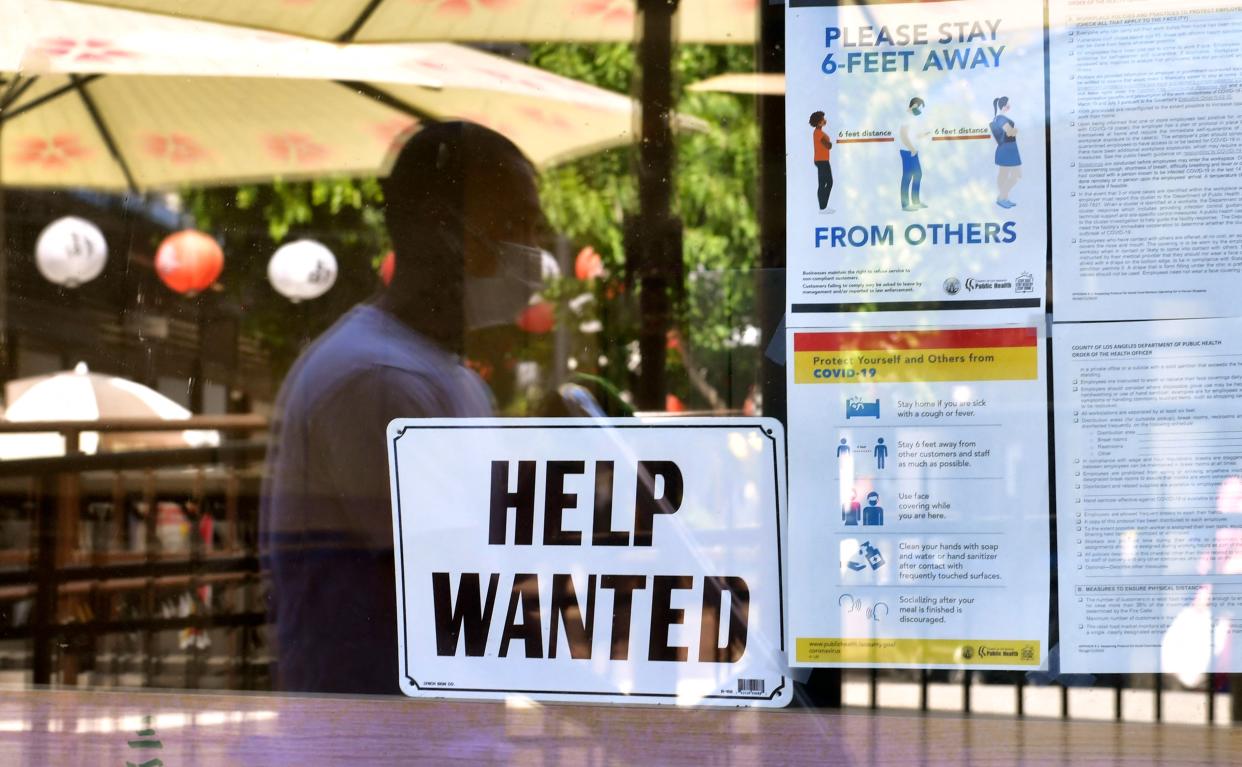'Lockdown' states like California did better economically than 'looser' states like Florida, new COVID data shows
Like seemingly everything else in America, the COVID-19 pandemic has sparked its fair share of bitter, polarizing debates: over masks, over distancing, over vaccines.
Lockdowns are no exception. One assumption many Americans seem to make is that the more a government limits gatherings, mandates masks, restricts business activity and advises residents to stay at home, the more economic damage it will do.
Among the loudest of these voices is Florida Gov. Ron DeSantis, a Republican who raised his national profile by allowing bars and restaurants to operate at full indoor capacity during America’s horrific holiday surge, then effectively banned mask mandates once Florida started to recover — all in the name of supporting business.

“She’s a lockdown lobbyist,” DeSantis recently said in reference to Democrat Nikki Fried, one of his 2022 gubernatorial opponents. Speaking at a New Smyrna Beach restaurant, DeSantis said Fried “would have had this business shuttered for the whole year. They would be out of business if Fried were governor.”
Yet for much of the past year, some experts have quietly advanced a counterargument: that economic activity is mainly affected by the rising and falling severity of the pandemic itself — not the relative strictness of the measures implemented to mitigate it. In fact, these experts argued, nonpharmaceutical interventions, or NPIs — a set of 20 government responses such as business closures, mask mandates and stay-at-home advisories that Oxford University rates according to stringency — can have an economic upside. The more the virus seems to be under control, the more eager people will be to participate in the economy.
Last week, this argument got a boost with the publication of a new report by economists at the University of California, Los Angeles. According to the latest quarterly UCLA Anderson Forecast, not only did big states with more stringent COVID measures end 2020 with fewer infections per capita, they also tended to post better economic growth numbers last year than states with fewer restrictions.
In other words, California’s economy actually fared better than Florida’s.
Yahoo News spoke with economist Jerry Nickelsburg, the director of the UCLA Anderson Forecast, to find out more.

Yahoo News: Is it now fair to say that so-called lockdown states performed better economically than so-called looser states during the 2020 pandemic?
Jerry Nickelsburg: That is correct. We generally view economic performance through the lens of gross domestic product. On average, GDP declined in 2020, and it declined everywhere. But those declines were smaller in states with more stringent nonpharmaceutical interventions than states with less stringent NPIs.
That’s the opposite of the conventional wisdom. In Florida, Republican Gov. Ron DeSantis is telling voters, in effect, “I saved the economy by opening bars and banning masks.” What made you suspect that the prevailing narrative — this idea that there’s a trade-off between public health and the health of the economy — might be wrong?
It was something that we started to see in Scandinavia. It's something we saw in the 1918-19 influenza pandemic as well. It seemed to be more than just a fluke.
When you say “something,” what do you mean?
The evidence suggested that policies that are good for people’s health during a pandemic — like NPIs — are not necessarily bad for the economy. There might even be a positive correlation. But early on, we did not have any 2020 pandemic data to answer that question. So it was open for debate.
But now we have that data.
Now we do.
Walk us through what it says.
The states that were considered for this analysis are basically the states that produce most of the U.S. GDP — states with a population of 5 million or greater. We found two things. First, California had more stringent interventions and a lower infection rate than either Texas or Florida, two states to which it’s often compared. Yet California also performed better with respect to GDP than either Texas or Florida. Second, the same pattern showed up across all big states: On average, the ones with more stringent interventions had both better health outcomes and better economic outcomes.

How do we know this has anything to do with COVID restrictions? Couldn’t it just be a coincidence — that some state economies were better suited to weather this particular storm, regardless of how stringent their interventions were?
To be sure, states have different economic compositions. But that’s one reason we didn’t include small states like North Dakota. Even though it had very poor health outcomes, North Dakota can do very well in terms of GDP when oil prices go up, because of the dominance of petroleum production in the value of goods and services produced there.
In contrast, large states typically have more diverse economies. And when you line them up according to their interventionist policies, you find that states that intervened more heavily tended to have fewer COVID cases per capita and smaller declines in GDP.
There were two outliers: New York and Michigan. Both had stringent NPIs but lost a lot of ground in terms of GDP. Why?
Michigan was all about supply chain interruption in the automobile industry. This had nothing to do with interventions. Factories were forced to close for part of the year.
What about New York? In the report you write, “Perhaps the economic performance [there] has more to do with remote work than the pandemic per se.”
We don’t know the answer. It may be that because of “work from home,” many New York employees were working from New Jersey or Connecticut or even Florida, and spending their money there.

Someone like Gov. DeSantis would disagree with your conclusions, and one argument he would make is that if restrictions are so great, then why is California’s unemployment rate 8.3 percent while Florida’s is 4.3 percent? Is that a fair comparison?
It’s true that if unemployment is your metric, California has a very high rate relative to Florida. But people who dropped out of the labor force because of COVID — either because they contracted it or because of concern for themselves or their families — are not counted in the unemployment rate. Likewise, there’s evidence that states that opened up earlier may have reduced their employees’ hours because fewer people were coming through the doors; the reduction in hours per employee was 4.2 percent in Texas versus 1.1 percent in California. So unemployment is actually quite complicated, and you can’t really rely on it.
[The UCLA report also suggests that “the answer lies in the structure of the California economy.” In California, “sectors with a high degree of human contact” — that is, “leisure and hospitality, education, retail trade, and health care and social services” — contributed only “0.3 percentage points to annual GDP growth over the decade preceding the pandemic.” But last year, “they accounted for 75 percent of the state’s job losses.”
Meanwhile, the sectors driving growth in California — “information, professional and business services, manufacturing and financial services” — weren’t hit nearly as hard. That helps to explain the discrepancy between the state’s unemployment rate and its overall economic performance. UCLA expects “many of those lost jobs to return.”]

What about 2021? California has kept many of its restrictions in place for the first half of the year. Florida has not. Yet due to vaccination, cases have been going down in both states for months now. Does that change anything?
The data we have for 2020 is pretty conclusive. The data for the 1918-19 pandemic is pretty conclusive. The data for Scandinavia is pretty conclusive. So far, the data says that with NPIs, there's no trade-off between better health outcomes and better economic outcomes. I don’t expect that to change.
____
Read more from Yahoo News:
